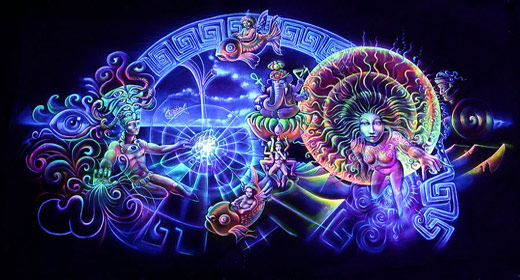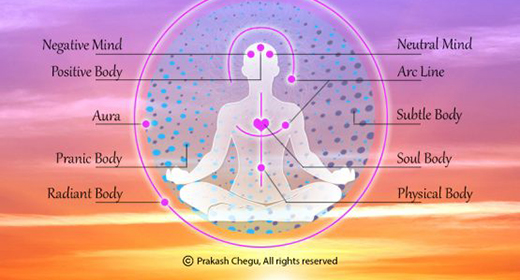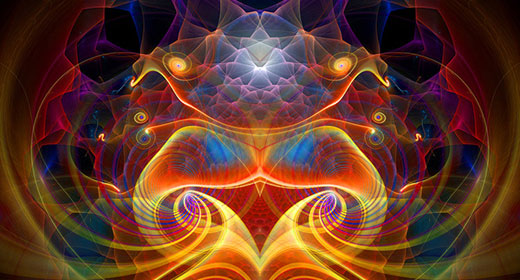by Swami Krishnananda: No aspiration can be fulfilled permanently or substantially if that which one aspires for stands totally isolated from one’s own being…

All that we have gathered up to this time by our discussions is that Being cannot be segregated into segments of subjectivity and objectivity. It is an impartite, ubiquitous expanse of Being. Remember, it is impartite; it cannot be partitioned into the subjective side and the objective side. Therefore, what you are asking for, aspiring for or what you want, without your knowing it clearly, is inseparable from Being as such, which you are identifying with your own self and considering other things as non-Being. No person can imagine that another thing is also a Self or a Being as such. “Everything is outside me and, therefore, it cannot be me.” And “I am existing; I am being.” We deny this character of existence to another when we call it ‘another’. The word itself is anathema. There is no ‘another’ for Being. It is just what it is.
Hence, wanting anything, desiring anything, is an abnormal function of the mind. It is kind of disease, we may say, that has crept into the very operative medium which is the psyche and, therefore, no desire can be fulfilled permanently or meaningfully. Everyone knows that desires have gone without having getting what they wanted. Everywhere there is bereavement; everywhere there is loss; everything runs away from your hand. Nothing wants to come near you because you never treat anything as pure Being, as Selfhood by itself. You treat everything else as a servant, a subservient, a satellite, an object, an instrument. This will not work. Would you like to be treated as a satellite of somebody? An instrument of somebody? A slave of somebody? If that is the case, nothing in the world will tolerate this attitude from ourselves. The great dictum of Yagnavalkya Maharshi in the Brihadranyaka Upanishad is sarvam tam paradat yah anyatra atmanah sarvamveda: The whole world will run away from you if you think it is outside you. “Oh, you are thinking that I am external to you, not connected to you; that I am not you. What connection have I got with you? I run away from you.”
Everything escapes the grip of human desire. This problem has been tackled in its very depths by the great sage Patanjali in his Yoga Sutras, when he pointed out that permanent happiness, which is the same as permanent possession of eternal values, is possible only by union of Consciousness with Being. Chit has to become Sat; and this Chit also is Sat. The consciousness in us is existence. It is actually the consciousness of existence. It is existence that is conscious of itself. The world ‘of’ cannot be applied here. It is not consciousness of existence; it is not existence with consciousness. It is existence that is consciousness. So is the case with everything else in the world.
This unique attempt on the part of this so-called subjective existence-consciousness to unite itself with the existence-consciousness of an outside so-called object, that attempt is called samadhi. The word ‘samapatti’ is also used by Sage Patanjali.
When we observe something, a person or an object, we create a mix-up of issues and do not see the thing or person properly. What is this mix-up? Everything, every person, whatever it is, has a designation, a characteristic, a name that we give. This is a tree, this is water, this is fire, this is earth, this is gold, this is silver, this is man, this is woman, this is this, this is that. This distinguishing designation that we attribute to a thing is what Patanjali calls name. Name, idea and substantiality are mixed up in our observation of anything whatsoever. There is a substantiality or an existence as such of everything. You exist, I exist, everything exists. But that which exists has no name of its own. Nobody is born with a name, really speaking. A name is given afterwards by social associations and relationships which are purely external. It is also possible for a person to exist without a name. When a child is born, don’t give it a name; then see whether it survives or not. It cannot survive, because of the social characteristic being implanted in the very existence of a finite individual.
We have to give a name to distinguish one thing from the other. Suppose nothing has a name. We will not be able to point out which particular thing it is that we are thinking of in our mind. In order that we may have a proper intelligible relationship with anything, a demarcating definition is created by us, a nomenclature, a definition, a characterisation – a name. So, we have created this problem.
We say it is a tree. Why should that particular thing standing there be called by that name only? Is there no possibility of defining it by any other name? It is possible. You say I am so-and-so. That is your name. It is not necessary that you should be only this person, hugging this name. Your parents could have given you another name altogether, and then you would cling to that name. You are initiated into a psychological obsession that you are identified with that particular name only, and the name is whispered into your ear again and again, again and again, by parents, relations and associates. “You are this. You are this. Do you know who you are? Come, this person, this person.” Otherwise, they could have called you by another name and you would be John, you would be Joseph. What does it matter? This is one aspect of the mix-up that we create in the observation of an object.
The other is more fantastic and very serious: the very idea that we have got about an object. There is a nomenclature, a verbal definition of everything. Now the ideational definition also comes up. We know that this is this and it is not something else. And this ideational distinguishing factor in respect of anything is independent of the name that we give to a particular thing. A monkey knows that there is a snake, though the word ‘snake’ may not be in the mind of the monkey because it is an English word and it can be called by any other name also. But the monkey knows what it is. Even without the name, the idea can point out immediately the nature of what is observed in front. The monkey will run away from that which is crawling like a snake. It will never go near it. Everybody will run away when that crawling thing is seen, though they don’t know the name of it.
So there is an ideational distinguishing factor in our mind in regard to something, apart from the name that we give to it. But minus this idea that we have about that thing and the name that we are attributing to it, it exists by itself. For instance, as I mentioned to you, if no name had been given to you, you would have certainly existed, though relationships with other people may be difficult because the distinguishing name is not present. But you will be hungry and thirsty and would like to have this or that. You would like to have something, like any other human being, though you have no name. It is social relationship that compels us to have a distinguishing name. If society is not there, if you have no connection with anybody else, you stand alone by yourself, then no name is necessary. Just imagine that you are alone somewhere. For a hundred miles distance from all sides nobody is there around you; will you go on calling yourself by the name that you are having? You will find that this name has no meaning, because nobody is there to call you, nor is it necessary to call yourself by that name. The name will vanish completely if for a hundred miles, on all four sides, nobody is there to call you by any name. Will you call a bird and tell it, “You are Mr. so-and-so?” To the bird it has no meaning. It seems that something is there. The substantiality and the characterisation is known even to a bird, but it does not know your name.
Patanjali says you must be able to distinguish a name and an idea from the substance of the object. I must be able to see you without associating a name to you and without having any notion about you in my mind. I should not prejudge your characterisation, because there is a great difference between my idea about you and your idea about your own self. You know it very well. And when you are absolutely alone, even your name is not necessary. So name and the idea that people have about you are redundant when you are totally alone to yourself. You stand as a pure substance and an existence as such of a particular nature.
Is it possible for anyone to think an object or a person in this manner – as it would know itself rather than as you would like to know it? For that purpose, you have to turn the tables around and place yourself in the context of that object and think as it would like to think. Impossible feat it may appear! How would you be able to transfer your being to the being of that which you are observing or you would like to see with your eyes? Then what happens, do you know? If you succeed in transferring your conscious existence into that existence-consciousness of that which you are beholding with your eyes or thinking with your mind, you will not be seeing it; it will be seeing you, rather. You would become the object, and that would become the subject.
Is it possible for you to convert the object into the subject and yourself as the object? Instead of your viewing it, let it view you and then see what happens. You will be humbled immediately. All ahankara, egoism, will go. “Oh, I am only an object of that thing which is looking at me.” But if this subject-object idea can be transcended, because if it can observe you as an object and you also can observe it as a subject, two subjects cannot stand apart from each other; they coalesce into a wider subject. This coalescing of the so-called observing subject with the observed subject is samadhi. At that time, who thinks what? It is difficult to say anything. It is a higher self operating with the so-called subjective self and the objective self, as two wings of a bird, as it were. To some extent I can compare this situation to the two wings, the characterisations of the Substance of Spinoza. You have read Spinoza’s philosophy. He considers the Ultimate Reality as a substance. Thought and extension are wings of this bird of Pure Substance. On one side there is extension, on the other side there is thought. These are the two characteristics of Substance as it is. But they are vital, integral, conscious wings of this bird called Substance. It flies with the two wings. And minus the two wings, it is no more a bird that can operate in that manner. In a similar manner, there is a substance that is transcending both the subjective selfhood and the objective selfhood, bringing them together into a comprehensive transcendence of themselves which sees both sides, like the two wings of a bird, and neither you are there as a subject nor the other thing is there as a subject. The two subjects are the two integral aspects of a transcendental subject which are called Substance in the language of Spinoza.
All great thinkers have suggested this method of contemplating the Ultimate Reality in their own languages, in their own way of approach. Here I am reminded of the dialectical process which is introduced by the great German philosopher Hegel. There is a position and an opposition, and a synthesis of both these things into one in a transcendent perception. For any kind of assertion, there is a counter-assertion. If you say something is ‘this’, you have avoided something which ‘this’ is not. So you cannot set aside the ‘this is not’ from the ‘this’ without consciously knowing that you have done this act. So the consciousness that knows that the ‘this’ is isolated from the ‘not this’ is transcendent to both the ‘this’ and the ‘not this’, and that transcendent is the synthesis. I hope you understand what I mean. This is exactly what I mentioned to you in another style – that Pure Consciousness knows the left side and the right side, if you would call it so. Two subjects cannot really be two subjects. They are only two wings of one Consciousness-Existence – call it Substance, call it Transcendental Being. That synthesis of both the position and the anti-position, the opposition, stand merged together into a transcendental unitary consciousness which is wider existence. This is samadhi of an object. You have ceased to become an observer of an object; it has become you. When it becomes you, you don’t want it anymore. Your love for it has gone, because it is like loving one’s one self. Who will hug oneself? In that way, all your desire for things will melt into this unitary merging of the objectivity into the transcendent subjectivity, which is what you are going to experience in samadhi.
According to Patanjali, there are stages of samadhi. You do not suddenly jump into the eternal unification; it has to be done very gradually. The Patanjali sutra says that you can attain samadhi with anything, even a pencil – a very tiny object. You can yourself become the pencil and start moving, and it will speak to you. You think a pencil cannot speak to you, that it is a stupid, inanimate object. There are no stupid, inanimate objects in the world. You have converted them into stupidity by your segregation of them from your being, and you regard them as non-being. No. The being and the non-being are two segments of a transcendent being. Therefore, a pencil does not exist. It is one side of a transcendent being. Thus it is that you can attain samadhi with a little microphone, with a pencil, with a transformer, with anything that you like, and it will become your friend. Can you imagine that a wall can become your friend?
There was a mystic called Ouspensky, a Russian mystic. He had a perceptive capacity beyond ordinary human comprehension. He went to a hotel in Russia and saw an ashtray. Due to his perceptive capacity he could see in those ashes the faces of everybody who had used the ashtray. So many people had smoked cigarettes and thrown the ashes. He looked at the walls and could see the pictures of all those people who had occupied that room – because walls are not dead, inert bricks. They are vibratory organisations of the same force which constitutes the body and psychic condition of a person. So vibrations strike vibrations. If you go deep into the substance of your own self, you will be able to see the vibrations around you, and you will feel something which is quite different from what you usually feel.
So according to Patanjali, samadhi, samapatti, union, can be attained in anything – in a leaf, in a tree, in a flower, in any object whatsoever. But the aim is not that. It is only a preparatory, kindergarten stage of union that is described in the Sutras of Patanjali, because samadhi is a way of liberation of spirit. It is kaivalya moksha that you are asking for – supreme aloneness of Absolute self-identical being. That is what you are asking for.
For that purpose, all the things that you consider as objective should become the centre of your attention. Not only one little thing such as a rose flower, a fruit, a pencil, and so on – they are only preparatory stages. All things should be taken together in their unitary appearance; the entire material substance – the earth, the entire earthly phenomenon here. By ‘earth’, we do not mean only this ground on which we are sitting. It means anything constituted of material substance. The entire matter which is having a name, as you call it, and an idea that you have about it, should be separated from the thing as it is in itself. Contemplate the whole earth contemplate as your own body. Any mind that is not prepared for it cannot do this kind of meditation, because distractions which are rajasic and tamasic in their nature will not allow you. I am not saying that this samadhi can be attained so easily, but as I am taking up this subject, I have to tell you everything connected with this great theme of the Yoga Sutras of Patanjali.
Unless you are united in your being with that which you expect to have, you cannot expect anything. This is the whole principle of samadhi. If you want a universal experience of absolute be-ness, that has to become the being of your own being. It should not stand outside as a distant, far away vision of a heaven – many, many light years away. If you think God is endlessly far, at an infinite distance, you will ever remain as you are. If you distance yourself from an object, it will distance itself from you. It will do tit for tat.
So, in the beginning the whole earth principle in its visible form is taken as an object of samadhi. It is not ordinary meditation in the sense of thinking something. It is not thinking something; it is beingsomething. That is samapatti, or samadhi. In ordinary perception we think something, observe something. Here the thing has become that which thinks. The thought of the object becomes the thought of the subject. Which subject? Again I mention to you, it is the subject that transcends the subjectivity of the observer and the objectivity so-called of the object, such that the objectivity also becomes a subjectivity, both of which are transcended in a higher synthesis of subject. This is how samapatti is described by Patanjali, in his own traditional language.
Now here again, when you consider the whole physical matter, the entire earth principle as the object of your samadhi, it has to be divested of the name that you have given to it and the idea that you have got about it. You should not say it is made up of some chemical substances or it is only some atoms and molecules, electric vibrations and it is called Earth, and it is distinguished from other things, other planets. These ideas also must go. The Earth is not distinguishable from other things, because it is constituted in the same way that any other planet is constituted.
Do you know that the planets are supposed to have come from the Sun? If you think that this is so, all the characteristics of the Sun are in every planet by the process of condensation. What is this Earth? It produces magnificent things. It gives you wheat and rice, there is sugarcane, there are mangos, and wonderful, beautiful things are growing. From where do they grow? From the Earth. From where has the Earth come? You say it is a chip of the Sun, a piece that has been shot out from the Sun. A flaming, burning, gaseous, terrible thing is the Sun, which has shot off by condensation this thing that has become the mother of the production of wonderful things in this world. You can imagine that if the effect is in the cause, everything must be potentially in the Sun also. Even the mango fruit is there. How is it possible? These things that we eat as our diet are existing in some highly potentised, super-active form of force. That is why it is said: surya atma jagatas tasthushascha. This is a mantra from the Rig Veda. This Surya that you are beholding with your eye is the soul of everything. It is your soul, and the soul of every bit of matter, every leaf, every tree, every fruit, everything that grows. Can you imagine that this entire solar system is operating due to the Sun, which is the soul? We think it is something electromagnetic – helium, whatever it is. These definitions will not work. It is that which operates the externalised form of the planets and everything that can arise from the planets – just as we have a soul which determines the movement of the limbs of the body, and anything that we do is the soul operating. But we say there is alot of distance; that the Sun is so far away – ninety three million miles. No. Can you say that your soul is far away, that it is so many millions of miles away from your skin? The idea of distance and space is, again, to be abolished by the process of Samapatti or samadhi, about which I will speak a little later.
Thus, it is the recognition of the soulhood, selfhood, atmatva, the very existence of a transcendental nature in everything that you perceive, in the whole Earth atmosphere, including the solar system and the galaxies. Put them together into a mass, as it were, a conglomeration of material energy, and unite yourself with that. You become embracing consciousness. Great joy you must feel inside. Great joy! The Sun is your friend. What do you lack? Not only is he a friend, he has entered you. The soul of the whole solar system is the soul of your own person. All the planets dance around you. They are not dancing around the Sun outside, because his soul and your soul are identical. The solar system has entered into you. Nobody can know what will happen to you at that time. Why do people dance in ecstasy? Bhaktas, mystics, great saints and sages cannot control themselves in this experience. It is beyond comprehension. The body will break into pieces if you inject such energy into this person.
So go slowly, slowly, slowly. Don’t proceed in a hurry, in case something happens. First of all, see that you have no external desires; otherwise it will damage your whole system. This meditation is like dynamite. It can break things, and it can help you. It can break yourself if you touch it in an irresponsible manner. So these meditations are a great divine blessing; they are dangerous things also, at the same time, if the body and mind are not prepared. I am not again going into the whole preparatory process of yama, niyama, pranayama and so on. You know all these things very well, and I have no time to go into these details. But I am mentioning to you that unless there is already a preparatory discipline which has hardened your personality as a receptive medium of this great incoming power, you will not be able to withstand it. Six hundred volts entering into your body – it will burn you to ashes.
Meditation is the golden treasure before you. There is nothing that you cannot achieve. You have just to close your eyes and intensely ask That; no, don’t ask That, become That. The whole of samapatti is nothing but becoming That. If you deeply become That, there is a vibration, a response that emanates from That which is otherwise wrongly considered as external to you. There are no other people here. There are no other things in the solar system. The entire space-time complex, which is so incalculably great, cannot be considered as something that is operating internally to an outer cosmos. This whole world is a manifestation of space-time only.
You will be wondering what this is, how space-time, abstract concepts, ideas, can become solid Earth? How can they become? What is space? It is nothing. It is an emptiness, a vacuum. And time, another vacuum. You are saying that the coming together of two vacuums have created this solid Earth? How is this possible? Read a great book: Space, Time and Deity by Samuel Alexander. It is a great thesis that he wrote in the form of lectures in Scotland. He will explain to you how space condenses itself into the form of the Earth. Space does not exist as a vacuum, as Alexander said. The Upanishads say: tasmat va etasmat atmana akasas sambhutah; satyam jnanam anantam brahma,says the Taittiriya Upanishad. Existence-consciousness-infinity-bliss – that is the same Self of everything. From that, space came. What is the meaning of that? God created heaven and Earth; He separated the firmament, says the Bible. What is the meaning of that? What is the matter? The infinite plenum has become a vacuum, as it were; but that so-called vacuum, which looks like an emptiness, has emanated from a fullness which is the plenum of the Infinite. Therefore, the fullness is potentially present even in this so-called nihil which you call space-time.
By a gradational process of density and condensation, space-time has become vibrating air, the heat which is fire, the liquid and the solid earth. Now you know from where we have come and what we are made of – what are the things around us. We are made of that satyam jnanam anantamAbsolute; and if you want to call it space-time, okay, call it. The very ultimate causative substance of it, which has given rise to our perceptive faculty included, makes it impossible for us to consider anything as a segregated object. Yoga is nothing but the union of the subjective consciousness with the objective existence. That is yoga. Then in this union, the objectivity melts into the subjectivity. It becomes a transcendental subjectivity. This transcendental subject is called God Almighty. That is the Absolute. That is kaivalya. That is, attaining which, is called moksha.
Here is a little preparatory introduction to you about what samadhi, samapatti is. I shall try to continue this subject in detail another time.









































